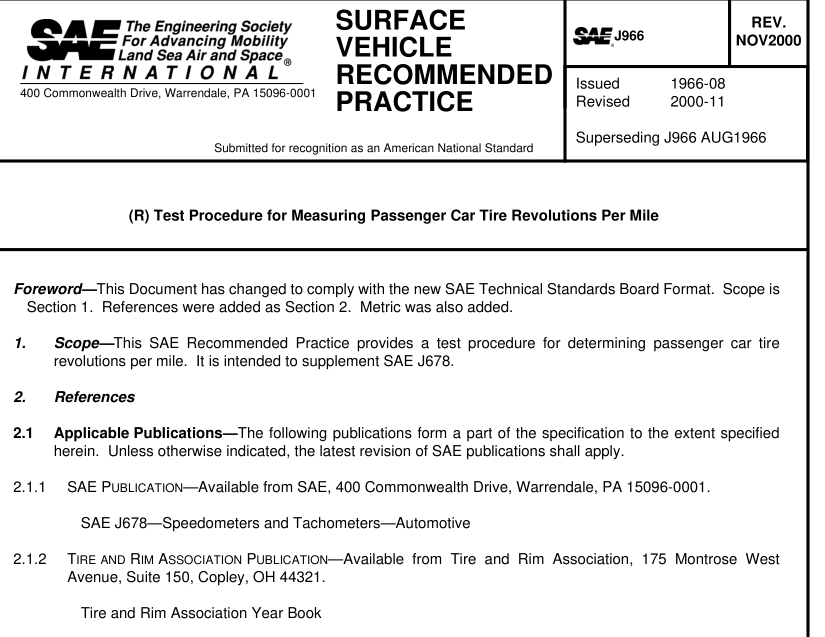SAE J966:2000 pdf download Test Procedure for Measuring Passenger Car Tire Revolutions Per Mile
1. Scope-This SAE Recommended Practice provides a test procedure for determining passenger car tre revolutions per mile. lt is intended to supplement SAE J678.
2.References
2.1 Applicable Publications—The following publications form a part of the specification to the extent specified herein. Unless otherwise indicated, the latest revision of SAE publications shall apply.
2.1.1 SAE PUBLICATION—Available from SAE, 400 Commonwealth Drive,Warrendale, PA 15096-0001.
SAE J678—Speedometers and Tachometers—Automotive
2.1.2 TIRE AND RIM ASsOCIATION PUBLICATION—Available from Tire and Rim Association,175 Montrose West Avenue, Suite 150, Copley, OH 44321.
Tire and Rim Association Year Book
3.Road Conditions—The test shall be a two mile, reasonably level straight-away section of dry pavement of consistent construction and surface, that is, concrete or blacktop. It should not have intermittent sections ofeach.
4. Temperature-Ambient test temperature shall be between 40 and 80 °F.
5.Vehicle Preparation and Test Load
5.1 Tire Position—Since most speedometers are actuated from the driveshaft, the tires to be tested should be installed on the drive wheel positions. The tires shall be a matched set of the same brand, having the samedegree of wear.
5.2Test Load—The load on each tire shall be the 88% maximum load rating for the particular size as given in the current Tire and Rim Association Year Book.
5.3 Breakin—Prior to the test, the tires shall be conditioned by running a breakin schedule of 1 61 km ± 32 km (1 00 miles ± 20 miles) at approximately 97 km/h (60 mph).
5.4 Test Speeds—Tire revolutions shall be counted at 72, 40, and 1 05 km/h (45, 25, and 65 mph) using a fifth wheel or calibrated vehicle speedometer for measurement of the test speed. 6. Method of Test—Tires shall be warmed up by a 1 6 km (1 0 mile) run on the straight-away at 72 km/h (45 mph).
After warmup, adjust the pressure of each tire to 200 kPa (29 psi) and immediately run the 3 km (2 mile) test at 72 km/h (45 mph), followed by the 40 km/h (25 mph) and 1 05 km/h (65 mph) test.
In the event of a stoppage or interruption of the test of sufficient duration to permit the tires to cool, the tire warmup and pressure adjustment to 200 kPa (29 psi) shall be repeated before resuming further tire revolution determinations. Count the tire revolutions required to traverse a distance of 3 km (2 miles) in each direction at a constant speed.
A measured course or calibrated fifth wheel may be used for distance determination. Tire revolutions per mile count at 72 km/h (45 mph) is derived by averaging the results of four runs (8 miles) which are within 1 % of each other. Repeat for 40 km/h (25 mph) and 1 05 km/h (65 mph). The revolutions per mile of the tested tires shall be determined for each speed, the 72 km/h (45 mph) revolutions being the standard value. Revolutions per mile for 40 and 1 05 km/h (25 and 65 mph) are recorded to show differences due to speed.
SAE J966:2000 pdf download
